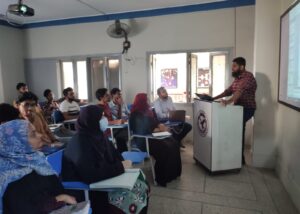How to Critically Analyze Artworks in Academic Assignments
Art analysis in academic assignments goes beyond describing what you see. It involves interpretation, contextual evaluation, and a critical understanding...

Art analysis in academic assignments goes beyond describing what you see. It involves interpretation, contextual evaluation, and a critical understanding of the meaning, technique, and impact of the artwork. Whether you’re studying fine arts, visual culture, or media studies, developing the skill to critically analyze artworks is crucial for academic success. This blog will guide you through the key methods and approaches to conduct insightful and academically strong art analysis, suitable for university essays, dissertations, or coursework.
Understanding how to approach a painting, sculpture, film still, or digital media piece in your analysis can help you build structured arguments and demonstrate your critical thinking abilities. Many students find this challenging and turn to services offering arts and media studies assignment help to navigate the demands of such tasks. However, with the right framework, you can learn to unpack artworks with confidence and present your analysis in a compelling academic format.
What is Critical Analysis of Art?
Critical analysis refers to evaluating an artwork through a lens of inquiry that goes beyond surface-level observation. It means questioning the purpose of the work, examining how it was created, and understanding the socio-cultural or historical context behind it. Critical analysis combines description, interpretation, and judgment to construct an informed viewpoint about the artwork’s significance.
In academic writing, this means forming arguments supported by visual evidence, art theory, and scholarly sources. You might explore questions like: What is the artist trying to communicate? What techniques were used, and why? How does this work reflect or challenge its cultural environment?
Key Elements of Art Analysis
When analyzing any piece of art, there are several elements to consider that will guide your evaluation and help structure your assignment.
1. Visual Description
Start with an objective description of what you see. This includes the subject matter, color palette, textures, lines, shapes, and composition. Avoid subjective interpretations at this stage. The purpose is to create a clear picture for the reader, especially if they’re unfamiliar with the artwork.
2. Formal Analysis
This step involves analyzing how the visual elements are organized. Consider how the artist uses space, perspective, contrast, rhythm, and balance. Ask yourself: Does the artwork follow traditional rules of composition, or does it break them for effect?
3. Contextual Information
Understanding the historical, cultural, and political context in which the artwork was created is essential. Who was the artist? What movement or era does this piece belong to? What societal issues were prevalent at the time? Context allows you to interpret the work on a deeper level.
4. Interpretation
Now move to your own interpretation. What do you think the artist is communicating? What emotions, ideas, or critiques does the artwork suggest? Use visual evidence and context to support your claims.
5. Evaluation
Finally, assess the artwork’s impact and significance. Is it effective in conveying its message? How does it compare to other works from the same period or movement? Has it influenced other artists or genres? Your judgment should be reasoned and supported by evidence.
Structuring Your Art Analysis Assignment
A well-organized structure is essential for presenting your art analysis clearly. Here’s a suggested format that can be used for essays or reports in arts and media studies:
Introduction
- Introduce the artwork and the artist
- Provide basic details (title, date, medium, dimensions)
- Present your thesis statement or main argument
Body Paragraphs
Each paragraph should focus on a single aspect of analysis. Begin with a topic sentence and support your ideas with detailed observations and scholarly references.
- Description – What does the artwork depict?
- Form and Technique – How is it constructed?
- Context – When, where, and why was it made?
- Interpretation – What meanings or messages emerge?
- Comparison – How does it relate to similar works?
Conclusion
Summarize your key points, restate your thesis in light of your analysis, and reflect on the overall importance of the artwork within its cultural or academic framework.
Academic Writing Style for Art Analysis
Your writing should maintain an objective and analytical tone. Avoid vague or overly emotional language. Instead, use precise vocabulary related to art theory and critique. Where possible, incorporate academic references, including books, journal articles, exhibition reviews, and critical essays.
Example:
Instead of saying, “The painting looks scary,” write, “The use of dark, saturated tones and sharp angular lines evokes a sense of unease and tension, aligning with themes of anxiety common in post-war Expressionist art.”
Common Theoretical Approaches
Depending on your course or assignment, you may be expected to apply specific theoretical frameworks. Here are some commonly used ones:
Formalism
Focuses purely on visual elements—line, shape, color, and composition—without considering historical or cultural context.
Iconography
Analyzes symbols and themes to uncover deeper meanings, often used in religious or classical art.
Feminist Theory
Explores gender dynamics in both the artwork’s content and the artist’s perspective. Who is represented, and how?
Postcolonial Theory
Examines the influence of colonial history, identity, and representation in global art, especially in formerly colonized societies.
Marxist Criticism
Looks at class struggle, power relations, and economic context in the creation and reception of artworks.
Psychoanalysis
Interprets artworks through Freudian or Jungian theory, analyzing unconscious desires, fears, and dreams.
Using these frameworks adds academic depth to your analysis and shows that you can engage with complex interpretive strategies.
Tips for Analyzing Different Art Forms
Paintings and Drawings
- Consider brushwork, color blending, and perspective
- Note how light and shadow create mood or focus
- Explore the symbolic meaning of imagery
Sculpture
- Observe material, texture, and spatial interaction
- Discuss how the sculpture engages with the viewer
- Consider how movement or stillness is portrayed
Photography
- Evaluate lighting, focus, framing, and timing
- Look at subject matter and emotional impact
- Contextualize within documentary, artistic, or political genres
Film and Media Art
- Analyze mise-en-scène, cinematography, editing, and sound
- Consider narrative structure and pacing
- Interpret themes using film theory (e.g., auteur theory or genre analysis)
Digital and Conceptual Art
- Discuss interactivity, innovation, or the use of digital tools
- Examine how technology transforms traditional artistic conventions
- Evaluate how meaning is constructed through non-traditional forms
Common Mistakes to Avoid
- Too Much Description, Not Enough Analysis
It’s important to go beyond stating what’s visible. Always aim to explain the ‘why’ and ‘how’. - Ignoring Context
Art doesn’t exist in a vacuum. Neglecting social, political, or historical background can weaken your analysis. - Subjective Overload
Avoid personal likes and dislikes unless they are academically relevant. Use evidence to support every claim. - Lack of Clear Argument
Your analysis should contribute to a larger thesis or line of reasoning. Without it, your paper may feel like a disconnected commentary. - Overuse of Jargon
Use technical terms where appropriate, but avoid unnecessary complexity. Clarity is key in academic writing.
How to Conduct Research for Art Analysis
Strong analysis is supported by solid research. Here’s how to gather information effectively:
- Visit galleries, museums, and exhibitions to experience artworks firsthand
- Read exhibition catalogues, curatorial notes, and artist statements
- Use academic databases like JSTOR or Art Full Text for journal articles
- Reference books on art history, theory, and criticism
- Consider reviews and critical essays by established art critics
Always cite your sources using the citation style required by your institution (APA, MLA, Chicago, etc.).
Conclusion: Develop Your Analytical Voice
Mastering the critical analysis of artworks takes practice, but it’s a rewarding skill that enhances both academic performance and personal appreciation of visual culture. Whether you’re analyzing a Renaissance fresco or a piece of interactive media, the ability to interpret and evaluate art with clarity and depth is essential for students in arts and humanities. Start by observing carefully, asking the right questions, and supporting your analysis with evidence and theory.
If you find yourself needing structured support, especially when juggling multiple deadlines, seeking arts and media studies assignment help from experienced academic services can be a smart solution. These services can provide guidance on analysis techniques, essay structuring, and source integration to help you meet academic standards without compromising integrity.
By applying the techniques outlined in this blog, you can approach any artwork with confidence and develop academic writing that not only meets the expectations of your professors but also showcases your unique interpretive voice.






